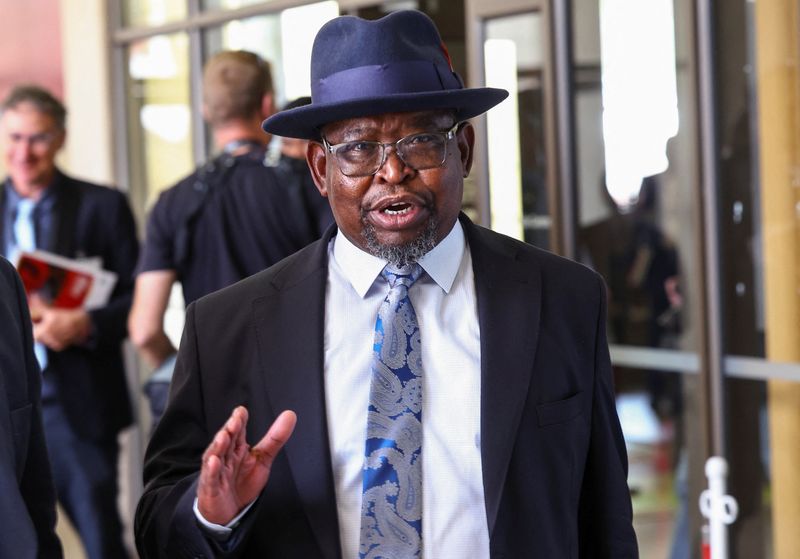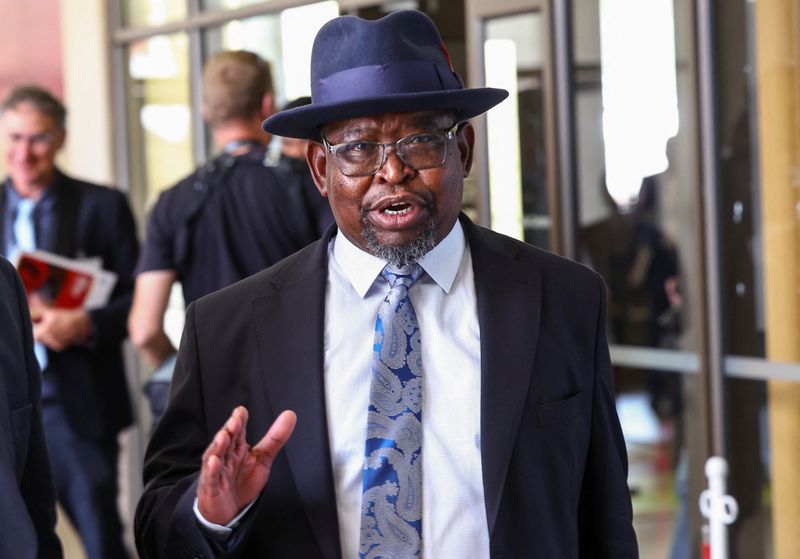Economy
South Africa seeks tax boost as higher debt peak forecast


© Reuters. South Africa’s Finance Minister Enoch Godongwana gestures after attending a press conference ahead of Godongwana’s medium-term budget policy statement in Cape Town, South Africa, November 1, 2023. REUTERS/Esa Alexander
By Kopano Gumbi, Anait Miridzhanian and Wendell Roelf
CAPE TOWN (Reuters) -South Africa’s finance minister will propose tax changes next year as part of an effort to stabilise public finances that are under strain from a drop in mining revenue, a mid-term budget review on Wednesday showed.
The budget document presented to parliament projected wider deficits over the next three years and saw debt peaking at a higher level than in February when the main budget was tabled.
Revenue collections in the current 2023/24 fiscal year were forecast to be 56.8 billion rand ($3.04 billion) below estimates in February.
The National Treasury said it was committed to spending reductions, moderate tax measures and efficiency gains from merging or closing public entities, some of which have required repeated bailouts in recent years.
“Given the extent of fiscal consolidation required, the Minister of Finance will propose tax measures to raise additional revenue of 15 billion rand in 2024/25 in the 2024 budget,” it said.
The treasury did not spell out what tax measures were envisaged.
The South African rand and bonds gained after the new budget forecasts, which were better than the market had anticipated, according to Andrew Matheny, an economist at Goldman Sachs.
“The overall message is doubling down on spending-led fiscal consolidation,” Matheny added.
STATE FIRMS DENT GROWTH
South Africa’s 2023 economic growth is now forecast at 0.8%, from 0.9% seen in February and the 1.9% growth recorded last year.
A major constraint on growth comes from state companies. Power utility Eskom is implementing the worst rolling power cuts on record, and inefficiencies at freight rail, ports and pipelines company Transnet have curbed commodities exports.
The treasury said it was amending Eskom’s debt-relief terms so loans to it would be interest-bearing, not interest-free, “to avoid a repeat of the mistakes in previous bailouts”.
Finance Minister Enoch Godongwana told Reuters on Wednesday that his team was working on a long-term solution to the problems at Transnet, which recently asked for a bailout, but he did not commit to providing a specific amount of financial support.
WIDER DEFICITS
A consolidated budget deficit of 4.9% of gross domestic product (GDP) is now expected in 2023/24, wider than a 4.0% deficit seen in February. Next year the treasury predicts a deficit of 4.6% of GDP and the following year 4.2% of GDP, also wider than previously forecast.
South Africa’s gross debt is expected to rise to 6.52 trillion rand in 2026/27 from 5.24 trillion rand in 2023/24. As a percentage of GDP, gross debt is seen stabilising at 77.7% of GDP in 2025/26 compared with 73.6% in the same year seen in February.
The treasury said the government would raise $2.4 billion in 2023/24 through concessional funding to meet its foreign-currency commitments.
South Africa is already paying high premiums in global bond markets, and compared with estimates in the February budget, debt-service costs are seen rising by 14.1 billion rand to 354.5 billion rand in 2023/24.
($1 = 18.7143 rand)
(Roelf reported from Cape Town and Gumbi and Miridzhanian from Pretoria; Additional reporting by Nellie Peyton, Bhargav Acharya, Tannur Anders and Rachel Savage in Johannesburg;Writing by Olivia Kumwenda-Mtambo;Editing by Alexander Winning, Kirsten Donovan)
Economy
Russian central bank says it needs months to make sure CPI falling before rate cuts -RBC


© Reuters. Russian Central Bank Governor Elvira Nabiullina attends a news conference in Moscow, Russia June 14, 2019. REUTERS/Shamil Zhumatov/File Photo
MOSCOW (Reuters) – Russia’s central bank will need two to three months to make sure that inflation is steadily declining before taking any decision on interest rate cuts, the bank’s governor Elvira Nabiullina told RBC media on Sunday.
The central bank raised its key interest rate by 100 basis points to 16% earlier in December, hiking for the fifth consecutive meeting in response to stubborn inflation, and suggested that its tightening cycle was nearly over.
Nabiullina said it was not yet clear when exactly the regulator would start cutting rates, however.
“We really need to make sure that inflation is steadily decreasing, that these are not one-off factors that can affect the rate of price growth in a particular month,” she said.
Nabiullina said the bank was taking into account a wide range of indicators but primarily those that “characterize the stability of inflation”.
“This will take two or three months or more – it depends on how much the wide range of indicators that characterize sustainable inflation declines,” she said.
The bank will next convene to set its benchmark rate on Feb. 16.
The governor also said the bank should have started monetary policy tightening earlier than in July, when it embarked on the rate-hiking cycle.
Economy
China identifies second set of projects in $140 billion spending plan


© Reuters. FILE PHOTO: Workers walk past an under-construction area with completed office towers in the background, in Shenzhen’s Qianhai new district, Guangdong province, China August 25, 2023. REUTERS/David Kirton/File Photo
SHANGHAI (Reuters) – China’s top planning body said on Saturday it had identified a second batch of public investment projects, including flood control and disaster relief programmes, under a bond issuance and investment plan announced in October to boost the economy.
With the latest tranche, China has now earmarked more than 800 billion yuan of its 1 trillion yuan ($140 billion) in additional government bond issuance in the fourth quarter, as it focuses on fiscal steps to shore up the flagging economy.
The National Development and Reform Commission (NDRC) said in a statement on Saturday it had identified 9,600 projects with planned investment of more than 560 billion yuan.
China’s economy, the world’s second largest, is struggling to regain its footing post-COVID-19 as policymakers grapple with tepid consumer demand, weak exports, falling foreign investment and a deepening real estate crisis.
The 1 trillion yuan in additional bond issuance will widen China’s 2023 budget deficit ratio to around 3.8 percent from 3 percent, the state-run Xinhua news agency has said.
“Construction of the projects will improve China’s flood control system, emergency response mechanism and disaster relief capabilities, and better protect people’s lives and property, so it is very significant,” the NDRC said.
The agency said it will coordinate with other government bodies to make sure that funds are allocated speedily for investment and that high standards of quality are maintained in project construction.
($1 = 7.1315 renminbi)
Economy
Russian central bank says it needs months to make sure CPI falling before rate cuts -RBC


© Reuters. Russian Central Bank Governor Elvira Nabiullina attends a news conference in Moscow, Russia June 14, 2019. REUTERS/Shamil Zhumatov/File Photo
MOSCOW (Reuters) – Russia’s central bank will need two to three months to make sure that inflation is steadily declining before taking any decision on interest rate cuts, the bank’s governor Elvira Nabiullina told RBC media on Sunday.
The central bank raised its key interest rate by 100 basis points to 16% earlier in December, hiking for the fifth consecutive meeting in response to stubborn inflation, and suggested that its tightening cycle was nearly over.
Nabiullina said it was not yet clear when exactly the regulator would start cutting rates, however.
“We really need to make sure that inflation is steadily decreasing, that these are not one-off factors that can affect the rate of price growth in a particular month,” she said.
Nabiullina said the bank was taking into account a wide range of indicators but primarily those that “characterize the stability of inflation”.
“This will take two or three months or more – it depends on how much the wide range of indicators that characterize sustainable inflation declines,” she said.
The bank will next convene to set its benchmark rate on Feb. 16.
The governor also said the bank should have started monetary policy tightening earlier than in July, when it embarked on the rate-hiking cycle.

 Forex2 years ago
Forex2 years agoForex Today: the dollar is gaining strength amid gloomy sentiment at the start of the Fed’s week

 Forex2 years ago
Forex2 years agoHow is the Australian dollar doing today?

 Forex1 year ago
Forex1 year agoUnbiased review of Pocket Option broker

 Forex2 years ago
Forex2 years agoDollar to pound sterling exchange rate today: Pound plummeted to its lowest since 1985

 Cryptocurrency2 years ago
Cryptocurrency2 years agoWhat happened in the crypto market – current events today

 World2 years ago
World2 years agoWhy are modern video games an art form?

 Stock Markets2 years ago
Stock Markets2 years agoMorgan Stanley: bear market rally to continue

 Economy2 years ago
Economy2 years agoCrude oil tankers double in price due to EU anti-Russian sanctions

































